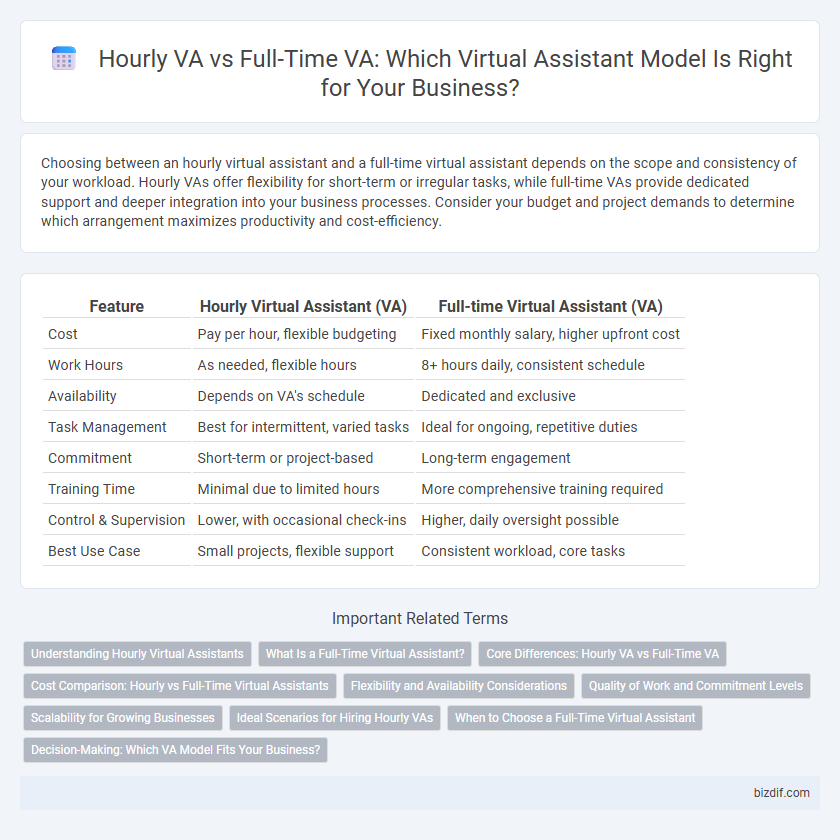Choosing between an hourly virtual assistant and a full-time virtual assistant depends on the scope and consistency of your workload. Hourly VAs offer flexibility for short-term or irregular tasks, while full-time VAs provide dedicated support and deeper integration into your business processes. Consider your budget and project demands to determine which arrangement maximizes productivity and cost-efficiency.
Table of Comparison
| Feature | Hourly Virtual Assistant (VA) | Full-time Virtual Assistant (VA) |
|---|---|---|
| Cost | Pay per hour, flexible budgeting | Fixed monthly salary, higher upfront cost |
| Work Hours | As needed, flexible hours | 8+ hours daily, consistent schedule |
| Availability | Depends on VA's schedule | Dedicated and exclusive |
| Task Management | Best for intermittent, varied tasks | Ideal for ongoing, repetitive duties |
| Commitment | Short-term or project-based | Long-term engagement |
| Training Time | Minimal due to limited hours | More comprehensive training required |
| Control & Supervision | Lower, with occasional check-ins | Higher, daily oversight possible |
| Best Use Case | Small projects, flexible support | Consistent workload, core tasks |
Understanding Hourly Virtual Assistants
Hourly virtual assistants offer flexible support tailored to fluctuating workloads, allowing businesses to manage tasks without committing to a fixed salary. They typically specialize in specific areas such as social media management, customer service, or administrative duties, enabling efficient task delegation. Understanding hourly virtual assistants helps organizations optimize operational costs while maintaining productivity during peak periods or short-term projects.
What Is a Full-Time Virtual Assistant?
A full-time virtual assistant (VA) is a remote professional dedicated to providing support and administrative services for approximately 40 hours per week, often becoming an integral part of a business's daily operations. Unlike hourly VAs who work on a flexible, pay-as-you-go basis, full-time VAs offer consistent availability and a deeper understanding of company processes, which enhances efficiency and task management. Hiring a full-time VA ensures ongoing communication, stronger workflow integration, and long-term commitment to business goals.
Core Differences: Hourly VA vs Full-Time VA
Hourly VAs offer flexible work arrangements and cost-efficiency for specific tasks or short-term projects, charging based on actual hours worked, making them ideal for businesses with fluctuating workloads. Full-time VAs provide consistent availability, deeper integration into company processes, and ongoing support at a fixed salary, ensuring continuity and long-term productivity. Core differences revolve around commitment level, cost structure, and scope of responsibilities, impacting business scalability and resource allocation.
Cost Comparison: Hourly vs Full-Time Virtual Assistants
Hourly virtual assistants offer flexible, cost-effective solutions for short-term or intermittent tasks, charging rates typically between $10 to $40 per hour depending on skill level and region. Full-time virtual assistants, salaried monthly between $1,200 and $3,500, provide consistent availability and deeper integration with business operations, often resulting in better long-term productivity. Businesses must weigh the predictability and potential savings of hourly rates against the dedicated support and potential economies of scale associated with full-time virtual assistant employment.
Flexibility and Availability Considerations
Hourly virtual assistants offer increased flexibility by allowing businesses to scale support up or down based on fluctuating workloads, making them ideal for project-based or intermittent tasks. Full-time virtual assistants provide consistent availability and deeper integration into daily operations, ensuring continuity and quicker response times for ongoing needs. Choosing between hourly and full-time VAs depends on balancing the need for adaptable scheduling against the requirement for steady, reliable presence.
Quality of Work and Commitment Levels
Hourly virtual assistants offer flexibility but may lack consistent commitment, often resulting in variable quality of work depending on task complexity and supervision. Full-time virtual assistants demonstrate higher dedication and integration with company culture, promoting better consistency and accountability in deliverables. Businesses prioritizing sustained quality and strong commitment typically benefit more from full-time VA arrangements.
Scalability for Growing Businesses
Hourly virtual assistants offer flexible scalability by allowing growing businesses to adjust support based on fluctuating workloads without long-term commitment. Full-time virtual assistants provide consistent availability and deeper integration, enhancing operational efficiency as business demands stabilize. Choosing between hourly and full-time VAs depends on the business's growth stage, workload variability, and need for scalability.
Ideal Scenarios for Hiring Hourly VAs
Hourly virtual assistants are ideal for businesses with fluctuating workloads, seasonal projects, or tasks requiring specialized skills for limited periods. Companies aiming to manage costs effectively while accessing expertise for short-term assignments benefit from hourly VA arrangements. Small businesses and startups often prefer hourly VAs to scale support flexibly without committing to full-time employment.
When to Choose a Full-Time Virtual Assistant
A full-time virtual assistant is ideal for businesses with consistent, ongoing workloads that require dedicated support across multiple tasks such as customer service, social media management, and administrative duties. When daily availability and deep integration with company operations are crucial, a full-time VA provides reliability and continuity that hourly VAs cannot match. Organizations experiencing rapid growth or needing specialized skills to handle complex projects benefit significantly from employing a full-time virtual assistant.
Decision-Making: Which VA Model Fits Your Business?
Choosing between an hourly virtual assistant (VA) and a full-time VA depends on your business's workload consistency and budget flexibility. Hourly VAs offer cost-effective support for fluctuating tasks and short-term projects, while full-time VAs provide dedicated, ongoing assistance that fosters deeper integration and reliability. Evaluating task volume, project duration, and the need for continuous availability guides the decision-making process for optimal VA model alignment.
Hourly VA vs Full-time VA Infographic

 bizdif.com
bizdif.com